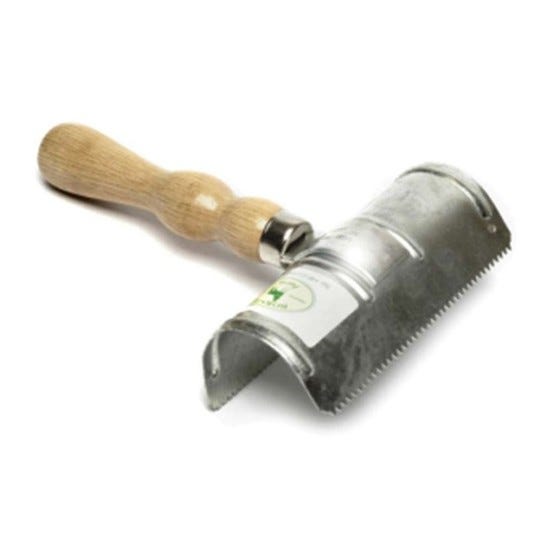The Medieval Curry Comb, or Strigil
One of the most essential items in any medieval grooming kit was the strigil, the precursor to today’s curry comb. Modern equestrians will instantly recognise this indispensable tool, which features rows of serrated ridges or teeth, typically made from plastic or rubber. It’s designed to remove mud, sweat, loose hair, and grease from a horse’s coat. While metal versions are still commonly used today for cleaning brushes, in the medieval period, the metal curry comb was designed for direct use on the horse.
Practical and effective, medieval curry combs served the same purpose as their modern counterparts, playing a vital role in equine care. These tools were a testament to how ancient traditions in horse grooming laid the foundation for the routines we use today.
Playing card. France, c. 1455
Crafting the Perfect Curry Comb
Medieval curry combs were usually crafted from a sheet of iron, which was curved to bring the long edges close together. These edges were then serrated, creating the familiar ridged surface. Finally, a wooden handle was attached at a right angle for ease of use. In the High Middle Ages, curry combs were a significant investment, costing around two pence each—equivalent to the daily wage of an average labourer at the time.
A Glimpse of History
Compare the similarities in design: (left) a detail from a 16th-century woodcut in the British Museum & (right) a modern curry comb


Curry Combs in Historical Documents
Medieval veterinary writers emphasised the importance of daily grooming, recommending the use of either a cloth or a curry comb on a horse’s body and limbs to maintain and clean its coat. However, some authors, like Albertus Magnus in the 13th century, warned against sharing these tools between horses, citing the potential for spreading skin conditions.
Royal stable accounts in the 13th and 14th centuries frequently list curry combs among their regular purchases. These tools may have been prone to getting lost amidst the hustle and bustle of the stable, but with each royal horse typically assigned a personal groom, it’s likely each had its own curry comb, in line with Magnus’s advice.
Medieval Use vs. Modern Use
While the design of the curry comb has remained largely unchanged over the centuries, the way we use it has evolved. In contrast to medieval grooms, we no longer regularly use curry combs directly on the horse’s body. This shift is documented in early 20th-century military regulations from Britain and America, which stipulated that curry combs should only be used for cleaning other grooming brushes, not for direct use on horses’ coats. The reason for this change in rules was that military horses now had to be clipped to prevent mange, and their sensitive skin could easily be damaged by the metal ridges of the comb.
Nevertheless, the presence of numerous curry combs in archaeological finds and historical records underscores that medieval horse owners were just as diligent about maintaining their horses' cleanliness as we are today.
For more information on the archaeology of medieval curry combs in London see John Clark’s The Medieval Horse and Its Equipment (Boydell, 2004)




